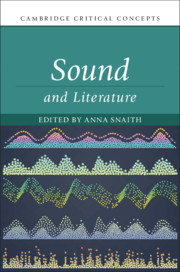Book contents
- Sound and Literature
- Cambridge Critical Concepts
- Sound and Literature
- Copyright page
- Epigraph
- Contents
- Figures
- Contributors
- Acknowledgements
- Introduction
- Part I Origins
- Chapter 1 Hearing and the Senses
- Chapter 2 Fragments on/of Voice
- Chapter 3 Sonic Forms
- Chapter 4 Classical Music and Literature
- Chapter 5 Aesthetics, Music, Noise
- Part II Development
- Part III Applications
- Bibliography
- Index
Chapter 1 - Hearing and the Senses
from Part I - Origins
Published online by Cambridge University Press: 29 May 2020
- Sound and Literature
- Cambridge Critical Concepts
- Sound and Literature
- Copyright page
- Epigraph
- Contents
- Figures
- Contributors
- Acknowledgements
- Introduction
- Part I Origins
- Chapter 1 Hearing and the Senses
- Chapter 2 Fragments on/of Voice
- Chapter 3 Sonic Forms
- Chapter 4 Classical Music and Literature
- Chapter 5 Aesthetics, Music, Noise
- Part II Development
- Part III Applications
- Bibliography
- Index
Summary
This chapter charts courses through a period roughly demarcated by the 1850s, at one end, and the 1930s at the other. It surveys ways in which hearing was treated both as a physiological and as an aesthetic object, and how these approaches converged with and diverged with one another. The chapter shows how nineteenth-century sense-physiology anticipates theories of language advanced early in the twentieth century by Ferdinand de Saussure and its attendant ‘sound-sense dialectic.’ This dialectic forms the crux of competing prospectuses for poetry advanced on either side of the turn of the century by figures as otherwise diverse as Grant Allen, Arthur Symons, T. E. Hulme, R. C. Trevelyan, Robert Graves, T. S. Eliot and James Weldon Johnson. Vernon Lee’s ‘physiological aesthetics’ traces one set of relations between words and recollections; another set features in Henry James’ prefaces to the New York Edition of his works, the pre-eminent statement on fictional aesthetics of their period. Drama is considered via its relation with the voice, as theorised by Yeats and in acting theory. Finally, this voice is considered as it features in the ‘gestural’ theory of language advanced by Richard Paget, and in F. Scott Fitzgerald’s The Great Gatsby.
- Type
- Chapter
- Information
- Sound and Literature , pp. 37 - 55Publisher: Cambridge University PressPrint publication year: 2020



